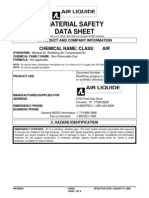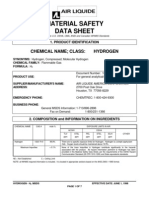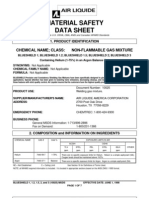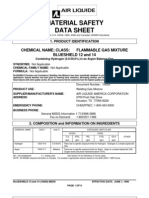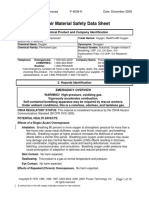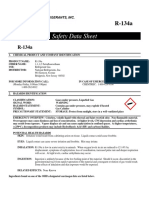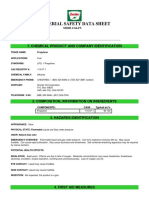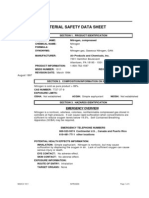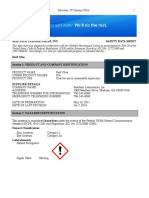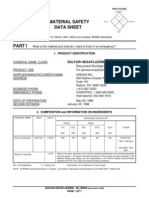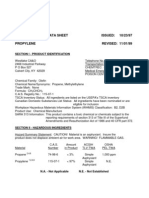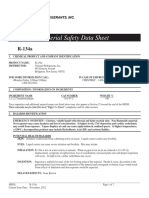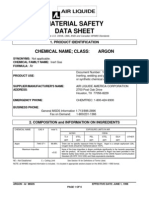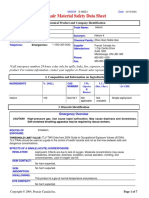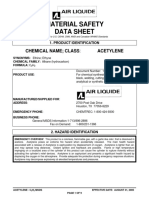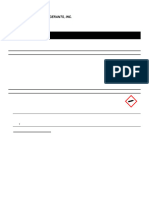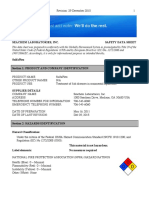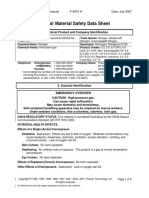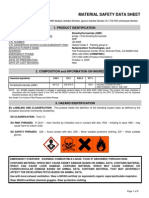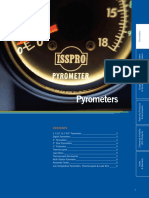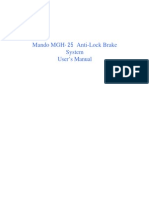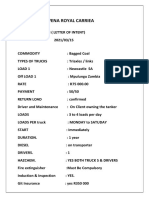Liquide Udara PDF
Liquide Udara PDF
Uploaded by
YovaniNissiMKetarenCopyright:
Available Formats
Liquide Udara PDF
Liquide Udara PDF
Uploaded by
YovaniNissiMKetarenOriginal Title
Copyright
Available Formats
Share this document
Did you find this document useful?
Is this content inappropriate?
Copyright:
Available Formats
Liquide Udara PDF
Liquide Udara PDF
Uploaded by
YovaniNissiMKetarenCopyright:
Available Formats
MATERIAL SAFETY
DATA SHEET
Prepared to U.S. OSHA, CMA, ANSI and Canadian WHMIS Standards
1. PRODUCT AND COMPANY INFORMATION
CHEMICAL NAME; CLASS: AIR
SYNONYMS: Medical Air, Breathing Air, Compressed Air
CHEMICAL FAMILY NAME: Non-Flammable Gas
FORMULA: Not applicable.
NOTE: Air may be either compressed, atmospheric air, or a mixture of 21% oxygen and 79% Nitrogen
NOTE: Air may be supplied by pipeline.
Document Number: 10003
PRODUCT USE: Breathing, purging or general analytical
or synthetic chemical uses.
MANUFACTURED/SUPPLIED FOR:
ADDRESS: 2700 Post Oak Drive
Houston, TX 77056-8229
EMERGENCY PHONE: CHEMTREC: 1-800-424-9300
BUSINESS PHONE:
General MSDS Information: 1-713/896-2896
Fax on Demand: 1-800/231-1366
2. HAZARD IDENTIFICATION
EMERGENCY OVERVIEW: Air is a colorless, odorless gas. The main health hazards associated with exposure
to this gas are related to the high pressure. Contact with rapidly expanding gases from a cylinder that is suddenly
released can cause frostbite to exposed skin or damage to eyes. Air is generally considered non-flammable,
however, Air will support combustion. A moderate cylinder rupture hazard exists when Air, which is under
pressure, is subject to heat or flames.
AIR MSDS (10003) EFFECTIVE DATE: AUGUST 31, 2005
PAGE 1 OF 8
2. HAZARD IDENTIFICATION (Continued)
SYMPTOMS OF OVER-EXPOSURE BY ROUTE OF EXPOSURE: The most significant route of over-exposure for
air is by inhalation at elevated or reduced pressure.
INHALATION: Air is non-toxic and necessary to support life. Inhalation of Air in high pressure environments, such
as underwater diving or hyperbolic chambers can result in symptoms similar to over-exposure to pure oxygen.
These symptoms include tingling of the fingers and toes, abnormal sensations, along with impaired coordination and
confusion. Decompression sickness, “bends”, is possible following rapid decompression.
CONTACT WITH SKIN or EYES: Contact with rapidly expanding gases (which are released under high pressure)
may cause frostbite. Symptoms of frostbite include change in skin color to white or grayish-yellow. The pain after
contact with liquid can quickly subside. Contact with the rapidly expanding vapors released the high pressure
cylinder may cause freezing of the eye. Permanent eye damage or blindness could result.
HEALTH EFFECTS OR RISKS FROM EXPOSURE: An Explanation in Lay Terms. Over-exposure to Air may
cause the following health effects:
ACUTE: The most significant hazards associated with air is the pressure hazard.
CHRONIC: There are currently no known adverse health effects associated with chronic exposure to this gas.
TARGET ORGANS: ACUTE: None. CHRONIC: None.
3. COMPOSITION and INFORMATION ON INGREDIENTS
CHEMICAL NAME CAS # mole % EXPOSURE LIMITS IN AIR
ACGIH-TLV OSHA-PEL NIOSH OTHER
TWA STEL TWA STEL IDLH
ppm ppm ppm ppm ppm ppm
Air 132259-10-0 100% There are no specific exposure limits applicable to air.
(compressed, atmospheric)
Mixed Air is a mixture of gases. The primary components of air, and the approximate concentration of each component, are listed below.
Nitrogen 7727-37-9 79% There are no specific exposure limits for Nitrogen. Nitrogen is a simple
asphyxiant (SA). Oxygen levels should be maintained above 19.5%.
Oxygen 7782-44-7 21% There are no specific exposure limits for Oxygen.
This material is classified as hazardous under OSHA regulations in the United States and the WHMIS in
Canada.
NE = Not Established. NIC = Notice of Intended Change See Section 16 for Definitions of Terms Used.
NOTE: ALL WHMIS required information is included in appropriate sections based on the ANSI Z400.1-2004 format. This product has been
classified in accordance with the hazard criteria of the CPR and the MSDS contains all the information required by the CPR.
4 FIRST-AID MEASURES
As the opportunity for injury from exposure to Air is limited to inhalation of Air in high pressure environments, such as
underwater diving or hyperbolic chambers, the first-aid measures would be for over-pressure accidents, or rapid
decompression-induced decompression sickness. In the event of such accidents, seek immediate and qualified
medical attention.
In case of frostbite, place the frostbitten part in warm water. DO NOT USE HOT WATER. If warm water is not
available, or is impractical to use, wrap the affected parts gently in blankets. Alternatively, if the fingers or hands are
frostbitten, place the affected area of the body in the armpit. Encourage victim to gently exercise the affected part
while being warmed. Seek immediate medical attention.
MEDICAL CONDITIONS AGGRAVATED BY EXPOSURE: A knowledge of the available information suggest that
over-exposure to Air is unlikely to aggravate existing medical conditions.
RECOMMENDATIONS TO PHYSICIANS: Treat symptoms and reduce over-exposure if air is breathed in high
pressure environment, (i.e. illness associated with decompression, bends, or caisson disease). Decompression
equipment may be required.
AIR MSDS (10003) EFFECTIVE DATE: AUGUST 31, 2005
PAGE 2 OF 8
5. FIRE-FIGHTING MEASURES
FLASH POINT: Not applicable.
AUTOIGNITION TEMPERATURE: Not applicable.
FLAMMABLE LIMITS (in air by volume, %):
Lower (LEL): Not applicable.
Upper (UEL): Not applicable.
FIRE EXTINGUISHING MATERIALS: Non-flammable. Air will support combustion of flammable materials. Use
extinguishing media appropriate for surrounding fire.
Water Spray: YES Carbon Dioxide: YES Dry Chemical: YES
Halon: YES Foam: YES Other: Any "ABC” Class.
UNUSUAL FIRE AND EXPLOSION HAZARDS: Air does not burn; however, cylinders, when involved in fire, may
rupture or burst in the heat of the fire.
Explosion Sensitivity to Mechanical Impact: Not Sensitive.
Explosion Sensitivity to Static Discharge: Not Sensitive.
SPECIAL FIRE-FIGHTING PROCEDURES: Incipient fire responders should wear eye protection. Structural fire-
fighters must wear Self-Contained Breathing Apparatus and full protective equipment. If possible, shut-off the flow of
Compressed Air supporting the fire. Immediately cool the cylinders with water spray from maximum distance. When
cool, move cylinders from fire area, if without risk.
6. ACCIDENTAL RELEASE MEASURES
LEAK RESPONSE: Uncontrolled releases should be responded to by trained personnel using pre-planned
procedures. Proper protective equipment should be used. In case of a release, clear the affected area, protect
people, and respond with trained personnel. Minimum Personal Protective Equipment should be Level D: safety
glasses. Locate and seal the source of the leaking gas. If this does not stop the release (or if it is not possible to
reach the valve), allow the gas to release in-place or remove it to a safe area and allow the gas to be released there.
If leaking incidentally from the cylinder or its valve, contact your supplier.
7. HANDLING AND STORAGE
WORK PRACTICES AND HYGIENE PRACTICES: Air intended for breathing must conform to CGA Standard G-7
(Compressed Air for Human Respiration) and Standard G-7.1, American National Standard Commodity
Specification for Air. All other sources of compressed air must be treated as unfit for human consumption until
tested for conformance with these standards.
STORAGE AND HANDLING PRACTICES: Compressed gases can present significant safety hazards. Store
cylinders away from heavily trafficked areas and emergency exits. Post “No Smoking or Open Flames” signs in
storage or use areas.
SPECIAL PRECAUTIONS FOR HANDLING GAS CYLINDERS: Protect cylinders against physical damage. Store
in cool, dry, well-ventilated, fireproof area, away from flammable or combustible materials and corrosive
atmospheres. Store away from heat and ignition sources and out of direct sunlight. Do not store near elevators,
corridors or loading docks. Do not allow area where cylinders are stored to exceed 52 °C (125 °F). Isolate from
incompatible materials including flammable materials. (see Section 10, Stability and Reactivity) for more information),
which can burn violently. Use only storage cylinders and equipment (pipes, valves, fittings to relieve pressure, etc.)
designed for the storage of Air. Do not store cylinders where they can come into contact with moisture. Cylinders
should be stored upright and be firmly secured to prevent falling or being knocked over. Cylinders can be stored in
the open, but in such cases, should be protected against extremes of weather and from the dampness of the ground
to prevent rusting. Never tamper with pressure relief devices in valves and cylinders. The following rules are
applicable to situations in which cylinders are being used:
Before Use: Move cylinders with a suitable hand-truck. Do not drag, slide or roll cylinders. Do not drop cylinders
or permit them to strike each other. Secure cylinders firmly. Leave the valve protection cap in-place (where
provided) until cylinder is ready for use.
During Use: Use designated CGA fittings and other support equipment. Do not use adapters. Do not heat
cylinder by any means to increase the discharge rate of the product from the cylinder. Use check valve in
discharge line to prevent hazardous backflow into the cylinder. Do not use oils or grease on gas-handling fittings or
equipment.
After Use: Close main cylinder valve. Replace valve protection cap (where provided). Mark empty cylinders
“EMPTY”.
NOTE: Use only DOT or ASME code cylinders. Close valve after each use and when empty. Cylinders must not
be recharged except by or with the consent of owner.
AIR MSDS (10003) EFFECTIVE DATE: AUGUST 31, 2005
PAGE 3 OF 8
7. HANDLING AND STORAGE (Continued)
PROTECTIVE PRACTICES DURING MAINTENANCE OF CONTAMINATED EQUIPMENT: Follow practices
indicated in Section 6 (Accidental Release Measures). Make certain application equipment is locked and tagged-out
safely. Always use product in areas where adequate ventilation is provided.
STANDARD VALVE CONNECTIONS FOR U.S. AND CANADA: Use the proper CGA connections, DO NOT
USE ADAPTERS:
THREADED: 0-3000 psig CGA 346 (alternative 590)
3001-5500 psig CGA 347
5501 - 7500 psig CGA 702
PIN-INDEXED YOKE: 0-3000 psig CGA 950 (medical use)
ULTRA HIGH INTEGRITY: 1160
8. EXPOSURE CONTROLS - PERSONAL PROTECTION
VENTILATION AND ENGINEERING CONTROLS: None needed.
RESPIRATORY PROTECTION: None needed.
EYE PROTECTION: Safety glasses. If necessary, refer to U.S. OSHA 29 CFR 1910.133 or appropriate Canadian
Standards.
HAND PROTECTION: Wear gloves when handling cylinders of this product. If necessary, refer to U.S. OSHA 29
CFR 1910.138 and appropriate Standards of Canada.
BODY PROTECTION: Use body protection appropriate for task. Safety shoes are recommended when handling
cylinders. If a hazard of injury to the feet exists due to falling objects, rolling objects, where objects may pierce the
soles of the feet or where employee’s feet may be exposed to electrical hazards, use foot protection, as described in
U.S. OSHA 29 CFR 1910.136.
9. PHYSICAL and CHEMICAL PROPERTIES
GAS DENSITY @ 21.1°C (70°F) and 1 atm: 0.07493 lb/ ft3 (1.2 kg/m3)
FREEZING/MELTING POINT @ 10 psig: -216.2°C (-357.2°F) MOLECULAR WEIGHT: 28.975
SOLUBILITY IN WATER, Vol/Vol at 0°C (32° F): 0.0292 pH: Not applicable.
SPECIFIC GRAVITY (air = 1) @ 21.1°C (70°F): 1 EXPANSION RATIO: Not applicable.
EVAPORATION RATE (nBuAc = 1): Not applicable. ODOR THRESHOLD: Not applicable.
SPECIFIC VOLUME (ft3/lb): Not applicable for Air; 13.8 (for Nitrogen)
VAPOR PRESSURE @ 21.1°C (70°F): Not applicable.
COEFFICIENT WATER/OIL DISTRIBUTION: Not applicable.
APPEARANCE, ODOR AND COLOR: This product is a colorless, odorless gas.
HOW TO DETECT THIS SUBSTANCE (warning properties): There are no unusual warning properties associated
with a release of this gas.
10. STABILITY and REACTIVITY
STABILITY: Normally stable in gaseous state. Compressed Air which contains excess oxygen may present the
same hazards as Liquid Oxygen and could react violently with organic materials, such as oil and grease.
DECOMPOSITION PRODUCTS: None.
MATERIALS WITH WHICH SUBSTANCE IS INCOMPATIBLE: Fuels may form explosive mixtures in air.
HAZARDOUS POLYMERIZATION: Will not occur.
CONDITIONS TO AVOID: Contact with incompatible materials, as listed above. Avoid exposing cylinders to
extremely high temperatures, which could cause the cylinders to rupture.
11. TOXICOLOGICAL INFORMATION
TOXICITY DATA: There are no specific toxicology data for Air.
SUSPECTED CANCER AGENT: Air is not found on the following lists: FEDERAL OSHA Z LIST, NTP, CAL/OSHA,
IARC, and there fore is not considered to be, nor suspected to be a cancer-causing agent by these agencies.
IRRITANCY OF PRODUCT: Not applicable.
SENSITIZATION OF PRODUCT: Air is not a skin or respiratory sensitizer.
REPRODUCTIVE TOXICITY INFORMATION: Listed below is information concerning the effects of Air on the
human reproductive system.
Mutagenicity: Air is not expected to cause mutagenic effects in humans.
Embryotoxcity: Air is not expected to cause embryotoxic effects in humans.
Teratogenicity: Air is not expected to cause teratogenic effects in humans.
Reproductive Toxicity: Air is not expected to cause adverse reproductive effects in humans.
AIR MSDS (10003) EFFECTIVE DATE: AUGUST 31, 2005
PAGE 4 OF 8
11. TOXICOLOGICAL INFORMATION (Continued)
A mutagen is a chemical which causes permanent changes to genetic material (DNA) such that the changes will
propagate through generation lines. An embryotoxin is a chemical which causes damage to a developing embryo
(i.e. within the first eight weeks of pregnancy in humans), but the damage does not propagate across generational
lines. A teratogen is a chemical which causes damage to a developing fetus, but the damage does not propagate
across generational lines. A reproductive toxin is any substance which interferes in any way with the reproductive
process.
BIOLOGICAL EXPOSURE INDICES (BEIs): Biological Exposure Indices (BEIs) do not exist for Compressed Air.
12. ECOLOGICAL INFORMATION
ENVIRONMENTAL STABILITY: This gas will be dissipated rapidly in well-ventilated areas.
EFFECT OF MATERIAL ON PLANTS or ANIMALS: No adverse effect is anticipated to occur to plant-life, except
for frost produced in the presence of rapidly expanding gases.
EFFECT OF CHEMICAL ON AQUATIC LIFE: No evidence of an adverse effect of air on aquatic life is currently
available.
13. DISPOSAL CONSIDERATIONS
PREPARING WASTES FOR DISPOSAL: Waste disposal must be in accordance with appropriate Federal, State,
and local regulations. Return cylinders with any residual product to Air Liquide. Do not dispose of locally.
For emergency disposal, secure the cylinder and slowly discharge the gas to the atmosphere in a well-ventilated
area or outdoors, away from all sources of ignition.
14. TRANSPORTATION INFORMATION
THIS COMPRESSED AIR IS HAZARDOUS AS DEFINED BY 49 CFR 172.101 BY THE U.S. DEPARTMENT OF
TRANSPORTATION.
PROPER SHIPPING NAME: ..... Air, compressed
HAZARD CLASS NUMBER and DESCRIPTION: 2.2 (Non-Flammable Gas)
UN IDENTIFICATION NUMBER: ..... UN 1002
PACKING GROUP: ..... Not applicable.
DOT LABEL(S) REQUIRED: ..... Non-Flammable Gas
NORTH AMERICAN EMERGENCY RESPONSE GUIDEBOOK NUMBER (1996): 122
MARINE POLLUTANT: Air is not classified by the DOT as a Marine Pollutant (as defined by 49 CFR 172.101,
Appendix B).
TRANSPORT CANADA TRANSPORTATION OF DANGEROUS GOODS REGULATIONS: This gas is considered
as Dangerous Goods, per regulations of Transport Canada. The use of the above U.S. DOT information from the
U.S. 49 CFR regulations is allowed for shipments that originate in the U.S. For shipments via ground vehicle or
rail that originate in Canada, the following information is applicable.
PROPER SHIPPING NAME: Air, compressed
HAZARD CLASS NUMBER and DESCRIPTION: 2.2 (Non-Flammable Gas)
UN IDENTIFICATION NUMBER: UN 1002
PACKING GROUP: Not Applicable
HAZARD LABEL(S) REQUIRED: 2.2 (Non-Flammable Gas)
SPECIAL PROVISIONS: 42
EXPLOSIVE LIMIT & LIMITED QUANTITY INDEX: 0.12
ERAP INDEX: None
PASSENGER CARRYING SHIP INDEX: None
PASSENGER CARRYING ROAD OR RAIL VEHICLE INDEX: 75
MARINE POLLUTANT: Compressed Air is not a Marine Pollutant.
AIR MSDS (10003) EFFECTIVE DATE: AUGUST 31, 2005
PAGE 5 OF 8
15. REGULATORY INFORMATION
ADDITIONAL U.S. REGULATIONS:
U.S. SARA REPORTING REQUIREMENTS: Compressed Air is not subject to the reporting requirements of
Sections 302, 304 and 313 of Title III of the Superfund Amendments and Reauthorization Act.
U.S. SARA THRESHOLD PLANNING QUANTITY: Not applicable.
U.S. TSCA INVENTORY STATUS: Air is listed on the TSCA Inventory.
U.S. CERCLA REPORTABLE QUANTITIES (RQ): Not applicable.
OTHER U.S. FEDERAL REGULATIONS:
• Air USP is regulated by the FDA as a prescription drug.
• Air does not contain any Class I or Class II ozone depleting chemicals (40 CFR part 82).
• Air is not subject to the reporting requirements of Section 112(r) of the Clean Air Act.
• Air is not listed as a Regulated Substance, per 40 CFR, Part 68, of the Risk Management for Chemical Releases.
• Air is not listed in Appendix A as a highly hazardous chemical, per 29 CFR 1910.119: Process Safety
Management of Highly Hazardous Chemicals.
CALIFORNIA SAFE DRINKING WATER AND TOXIC ENFORCEMENT ACT (PROPOSITION 65: Compressed
Air is not on the California Proposition 65 lists.
U.S. STATE REGULATORY INFORMATION: Air is not covered under the following specific State regulations:
Alaska - Designated Toxic and Hazardous Minnesota - List of Hazardous Substances: Pennsylvania - Hazardous Substance List:
Substances: No. No. No.
California - Permissible Exposure Limits Missouri - Employer Information/Toxic Rhode Island - Hazardous Substance List:
for Chemical Contaminants: No. Substance List: No . No.
Florida - Substance List: No. New Jersey - Right to Know Hazardous Texas - Hazardous Substance List: No.
Illinois - Toxic Substance List: No. Substance List: Air. West Virginia - Hazardous Substance List:
Kansas - Section 302/313 List: No. North Dakota - List of Hazardous No.
Massachusetts - Substance List: No. Chemicals, Reportable Quantities: No. Wisconsin - Toxic and Hazardous
Substances: No.
ADDITIONAL CANADIAN REGULATIONS:
CANADIAN DSL/NDSL INVENTORY STATUS: Compressed Air is included in the DSL Inventory.
CANADIAN ENVIRONMENTAL PROTECTION ACT (CEPA) PRIORITY SUBSTANCES LISTS: Compressed Air
is not on the CEPA Priorities Substances Lists.
WHMIS CLASSIFICATION: Compressed Air is categorized as a Controlled Product, Hazard Class A, as per the
Controlled Product Regulations.
OTHER CANADIAN REGULATIONS: Not applicable.
AIR MSDS (10003) EFFECTIVE DATE: AUGUST 31, 2005
PAGE 6 OF 8
16. OTHER INFORMATION
NFPA RATING HAZARDOUS MATERIAL IDENTIFICATION SYSTEM
FLAMMABILITY
0
HEALTH HAZARD (BLUE) 0
HEALTH 0 0 REACTIVITY
FLAMMABILITY HAZARD (RED) 0
OTHER
PHYSICAL HAZARD (YELLOW) 0
PROTECTIVE EQUIPMENT
EYES RESPIRATORY HANDS BODY
SEE SECTION 8 SEE SECTION 8
For Routine Industrial Use and Handling Applications
Atmospheric air that is compressed is composed of the following gases:
Nitrogen: 78%
Oxygen 21%
Argon 0.9%
Compressed air is also synthetically produced by mixing 79% nitrogen and 21% oxygen.
MIXTURES: When two or more gases or liquefied gases are mixed, their hazardous properties may combine to
create additional, unexpected hazards. Obtain and evaluate the safety information for each component before
you produce the mixture. Consult an Industrial Hygienist or other trained person when you make your safety
evaluation of the end product. Remember, gases and liquids have properties which can cause serious injury or
death.
Further information about Air can be found in the following pamphlets published by: Compressed Gas
Association Inc. (CGA), 4221 Walney Road 5th floor, Chantilly, VA 20151-2923. Telephone: (703) 788-2700.
G-7 “Compressed Air for Human Respiration”
G-7.1 “American National Standard Commodity Specification for Air”
P-1 “Safe Handling of Compressed Gases in Containers”
AV-1 "Safe Handling and Storage of Compressed Gases"
AIR MSDS (10003) EFFECTIVE DATE: AUGUST 31, 2005
PAGE 7 OF 8
16. OTHER INFORMATION (Continued)
PREPARED BY: CHEMICAL SAFETY ASSOCIATES, Inc.
PO Box 3519, La Mesa, CA 91944-3519
619/670-0609
Fax on Demand: 1-800/231-1366
This Material Safety Data Sheet is offered pursuant to OSHA’s Hazard Communication Standard, 29 CFR, 1910.1200. Other government
regulations must be reviewed for applicability to this product. To the best of Air Liquide’s knowledge, the information contained herein is
reliable and accurate as of this date; however, accuracy, suitability or completeness are not guaranteed and no warranties of any type, either
express or implied, are provided. The information contained herein relates only to this specific product. If this product is combined with other
materials, all component properties must be considered. Data may be changed from time to time. Be sure to consult the latest edition.
AIR MSDS (10003) EFFECTIVE DATE: AUGUST 31, 2005
PAGE 8 OF 8
You might also like
- 1988 g30 Chevy Van Repair ManualDocument178 pages1988 g30 Chevy Van Repair Manualwwwebcat67% (9)
- TM 9 2320 280 10 HR HMMWV Hand ReciptDocument20 pagesTM 9 2320 280 10 HR HMMWV Hand ReciptAUGieDogie1100% (1)
- Seachem Laboratories, Inc. Safety Data SheetDocument9 pagesSeachem Laboratories, Inc. Safety Data SheetJorge Restrepo HernandezNo ratings yet
- Research Methodology Hypothesis On Kia SeltosDocument2 pagesResearch Methodology Hypothesis On Kia SeltosAjitha P.NNo ratings yet
- Material Safety Data Sheet: Chemical Name Class: AIRDocument8 pagesMaterial Safety Data Sheet: Chemical Name Class: AIRprasad5034No ratings yet
- Liquid Oxygen MSdsDocument8 pagesLiquid Oxygen MSdssalcabesNo ratings yet
- Blue Shield 4-5 MSDSDocument7 pagesBlue Shield 4-5 MSDSsalcabesNo ratings yet
- Hydrogen MsdsDocument7 pagesHydrogen MsdssalcabesNo ratings yet
- Liquid Nitrogen MSDSDocument9 pagesLiquid Nitrogen MSDSsalcabesNo ratings yet
- Blue Sheild 1-3 MSDSDocument7 pagesBlue Sheild 1-3 MSDSsalcabesNo ratings yet
- Blue Shield 11 MsdsDocument7 pagesBlue Shield 11 MsdssalcabesNo ratings yet
- Blue Shield 12 & 14 MsdsDocument8 pagesBlue Shield 12 & 14 MsdssalcabesNo ratings yet
- MSDS N2Document6 pagesMSDS N2Achmad Nur HusainiNo ratings yet
- Matheson MSDS Sheet Methane AirDocument10 pagesMatheson MSDS Sheet Methane AirHarryNo ratings yet
- Helium MsdsDocument7 pagesHelium MsdssalcabesNo ratings yet
- Air CompressedDocument5 pagesAir CompressedRantyNo ratings yet
- MSDS Argon Compressed GasDocument6 pagesMSDS Argon Compressed Gassajid aliNo ratings yet
- 088 Oxygen Pressurized GasDocument8 pages088 Oxygen Pressurized Gaseng20072007No ratings yet
- Global SDS R 134aDocument7 pagesGlobal SDS R 134aEVAST FOR CHEMICALSNo ratings yet
- Oxygen Compressed Gas PraxairDocument10 pagesOxygen Compressed Gas Praxairnizam teknoconNo ratings yet
- Nitrogen MSDS PDFDocument7 pagesNitrogen MSDS PDFGangeshMishraNo ratings yet
- R22-msds ManualDocument9 pagesR22-msds Manualplantengineering7No ratings yet
- Material Safety Data Sheet: Chemical Name Class: Nonflammable Gas MixtureDocument4 pagesMaterial Safety Data Sheet: Chemical Name Class: Nonflammable Gas MixtureKaro toorNo ratings yet
- MVD 1&2 SDS R134aDocument8 pagesMVD 1&2 SDS R134ajessie rylesNo ratings yet
- Material Safety Data Sheet: 1. Product Identification Chemical Name Class: H A /H /N A G MDocument9 pagesMaterial Safety Data Sheet: 1. Product Identification Chemical Name Class: H A /H /N A G MbismuthsunilNo ratings yet
- SDS R11Document7 pagesSDS R11Rowi ArifudinNo ratings yet
- Evaluarea Şi Prevenirea Riscurilor ElectriceDocument7 pagesEvaluarea Şi Prevenirea Riscurilor ElectricebraduldelamalulmariiNo ratings yet
- SDS R22Document7 pagesSDS R22ERASTO ANTONIONo ratings yet
- Material Safety Data Sheet: What Is The Material and What Do I Need To Know in An Emergency?Document10 pagesMaterial Safety Data Sheet: What Is The Material and What Do I Need To Know in An Emergency?prasad5034No ratings yet
- Safety Data SheetDocument8 pagesSafety Data SheetNaqash RazzaqNo ratings yet
- Praxair Material Safety Data Sheet: Product: Methane P-4618-E Date: September 2004Document8 pagesPraxair Material Safety Data Sheet: Product: Methane P-4618-E Date: September 2004Dhinda ClariestaNo ratings yet
- Nitrogen AmerexDocument9 pagesNitrogen Amerexharanus2000No ratings yet
- AmmoniaDocument8 pagesAmmoniaPioneers qcNo ratings yet
- Propylene LPGDocument4 pagesPropylene LPGJohn KalvinNo ratings yet
- MSDS Nitrogen PDFDocument8 pagesMSDS Nitrogen PDFMaria ElaineNo ratings yet
- SDS R114Document8 pagesSDS R114tonyNo ratings yet
- Material Safety Data SheetDocument5 pagesMaterial Safety Data SheettranhungNo ratings yet
- Msds 1301 RemtecDocument5 pagesMsds 1301 RemtecJeremy KumarNo ratings yet
- Seachem Laboratories, Inc. Safety Data SheetDocument9 pagesSeachem Laboratories, Inc. Safety Data SheetJorge Restrepo HernandezNo ratings yet
- SF6Document7 pagesSF6MahsagolNo ratings yet
- Material Safety Data Sheet ISSUED: 10/23/97 Propylene REVISED: 11/01/99Document7 pagesMaterial Safety Data Sheet ISSUED: 10/23/97 Propylene REVISED: 11/01/99Apaq ApacheNo ratings yet
- Material Safety Data Sheet: Section 1. Chemical Product and Company IdentificationDocument5 pagesMaterial Safety Data Sheet: Section 1. Chemical Product and Company IdentificationAltif AboodNo ratings yet
- MSDS 134aDocument7 pagesMSDS 134aGamaliel Efren Santibañez RomeroNo ratings yet
- MSDS Liquide MSDSDocument4 pagesMSDS Liquide MSDSShaikhRizwanNo ratings yet
- Argon Helium MixesDocument13 pagesArgon Helium MixessalcabesNo ratings yet
- Aluminum StearateDocument6 pagesAluminum Stearatesajad gohariNo ratings yet
- Os 102 Boc Ozone MsdsDocument7 pagesOs 102 Boc Ozone MsdsVan SotNo ratings yet
- Nitrogen SDSDocument8 pagesNitrogen SDSJudin MathewsNo ratings yet
- 059 HeliumDocument7 pages059 Heliumeng20072007No ratings yet
- Density PDFDocument10 pagesDensity PDFBen Yudha SatriaNo ratings yet
- Material Safety Data Sheet: Chemical Name Class: AcetyleneDocument9 pagesMaterial Safety Data Sheet: Chemical Name Class: AcetyleneArian JackNo ratings yet
- Liquid Helium He Safety Data Sheet SDS P4600Document10 pagesLiquid Helium He Safety Data Sheet SDS P4600кирилл маркевичNo ratings yet
- MSDS R12Document8 pagesMSDS R12iqbal.shaheen103No ratings yet
- Seachem Laboratories, Inc. Safety Data SheetDocument9 pagesSeachem Laboratories, Inc. Safety Data SheetJorge Restrepo HernandezNo ratings yet
- Microsoft Word - 520 BLV MsdsDocument1 pageMicrosoft Word - 520 BLV MsdsEdwiin TamayoNo ratings yet
- Seachem Laboratories, Inc. Safety Data SheetDocument9 pagesSeachem Laboratories, Inc. Safety Data SheetJorge Restrepo HernandezNo ratings yet
- MSDS 134DFVHGDocument8 pagesMSDS 134DFVHGmynameismiakNo ratings yet
- Praxair Material Safety Data Sheet: Product: Nitrogen, Compressed P-4631-H Date: July 2007Document8 pagesPraxair Material Safety Data Sheet: Product: Nitrogen, Compressed P-4631-H Date: July 2007Galih SukmaNo ratings yet
- Mobil SHC Rarus 46 SDSDocument7 pagesMobil SHC Rarus 46 SDSjshkaNo ratings yet
- Msds Bleach KlorinDocument6 pagesMsds Bleach KlorinUswatun TreasuresNo ratings yet
- Dimethylformamide - Nugentec Ghs MsdsDocument8 pagesDimethylformamide - Nugentec Ghs MsdsstabinmathewNo ratings yet
- Material Safety Data Sheet: Texaco Rando® HD 100 - 220Document9 pagesMaterial Safety Data Sheet: Texaco Rando® HD 100 - 220evet cachoNo ratings yet
- The Toxicant Induction of Irritant Asthma, Rhinitis, and Related ConditionsFrom EverandThe Toxicant Induction of Irritant Asthma, Rhinitis, and Related ConditionsNo ratings yet
- Walking in A Tropical ClimateDocument15 pagesWalking in A Tropical ClimateDwiAndri Budiman KomoyNo ratings yet
- Transport Eng. Chap 2Document112 pagesTransport Eng. Chap 2Shife Man100% (1)
- Manual Utilizare Volvo V50Document259 pagesManual Utilizare Volvo V50Olivia Devi ChearaNo ratings yet
- A Summary of DRAFT Master PlanDocument16 pagesA Summary of DRAFT Master Planakhilchibber100% (1)
- MTHL Scope of WorkDocument12 pagesMTHL Scope of Worktariq1987No ratings yet
- Pyrometer Brochure (Exh - Gas Gauege BM - GloryDocument6 pagesPyrometer Brochure (Exh - Gas Gauege BM - GloryAlan SebastianNo ratings yet
- Parts Book: Sany Single-drum-RollerDocument203 pagesParts Book: Sany Single-drum-RollerJadir GonçalvesNo ratings yet
- Ground School TupiDocument37 pagesGround School TupiGustavo CastilhoNo ratings yet
- Del To BbiDocument3 pagesDel To BbiSudhanshu Sekhar SahooNo ratings yet
- Torts and Damages Compilation of CasesDocument60 pagesTorts and Damages Compilation of CasesScpo Presinto DosNo ratings yet
- Characteristics of RurbanizationDocument2 pagesCharacteristics of RurbanizationEditor IJTSRDNo ratings yet
- Comparative AdjectivesDocument1 pageComparative AdjectivesorianaNo ratings yet
- Record of Personal Information and Past Experience: AddressDocument4 pagesRecord of Personal Information and Past Experience: AddressLeana JuricaNo ratings yet
- Controllers - Fuses - Relays - Locations-01-01Document5 pagesControllers - Fuses - Relays - Locations-01-01suryabasarNo ratings yet
- MS - 304 - Dated 09.02.2001Document5 pagesMS - 304 - Dated 09.02.2001sujaraghupsNo ratings yet
- Maintenance Manual ABS PDFDocument39 pagesMaintenance Manual ABS PDFPedro Emilio Miguez CastrillonNo ratings yet
- Component Locator - Door Component ViewsDocument8 pagesComponent Locator - Door Component ViewsAlfonso BarrantesNo ratings yet
- Triumph Bonneville T100 SE Etc - Eng - PDFDocument2 pagesTriumph Bonneville T100 SE Etc - Eng - PDFAnonymous J9QuDonrRUNo ratings yet
- Sony LogisticsDocument2 pagesSony LogisticsShrishailya PanchavisheNo ratings yet
- Module Propulsion and SteeringDocument55 pagesModule Propulsion and SteeringSasha KaraNo ratings yet
- Welcome To The Cabin StreamDocument15 pagesWelcome To The Cabin StreamReuben JamesNo ratings yet
- Item 10B Pleasant Hill Road Rumble Strips PDFDocument38 pagesItem 10B Pleasant Hill Road Rumble Strips PDFBglpoo OfficerNo ratings yet
- Railway Track DesignDocument17 pagesRailway Track Designsrinibashb5546No ratings yet
- Mokwena Royal CarrieaDocument7 pagesMokwena Royal CarrieaJoseph MutitiNo ratings yet
- Bulletin NotesDocument11 pagesBulletin NotesjeanphiliptxtcalNo ratings yet
- NUS Engineering SERIUS Brochure Page ViewFA HRwoCmDocument6 pagesNUS Engineering SERIUS Brochure Page ViewFA HRwoCmGlenden KhewNo ratings yet
- Industrial Relations - Case - 2: Organizational Discipline - A Goal or A Means?Document2 pagesIndustrial Relations - Case - 2: Organizational Discipline - A Goal or A Means?JackSenNo ratings yet




